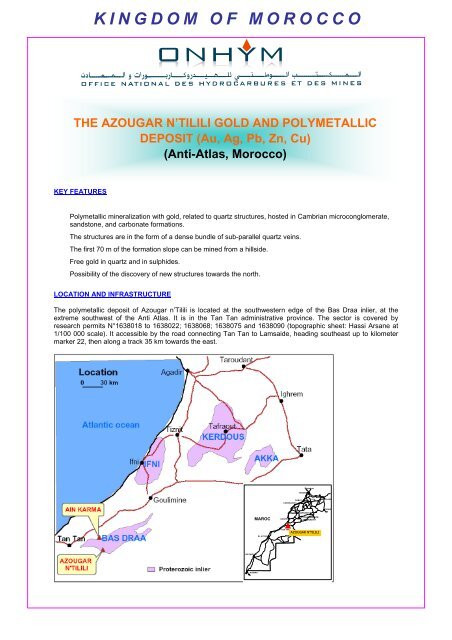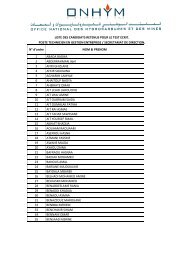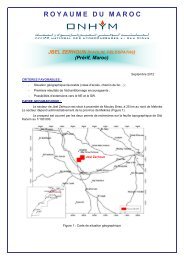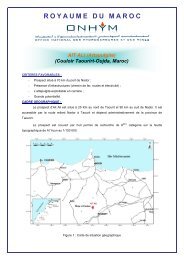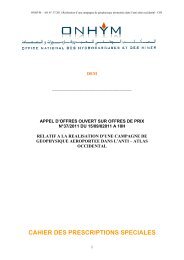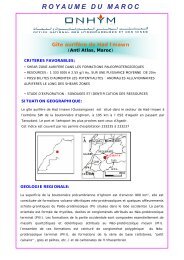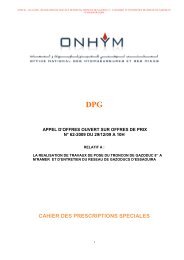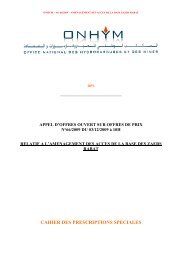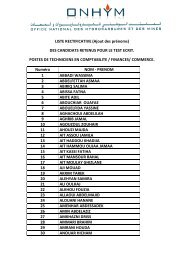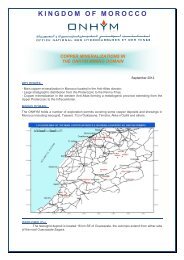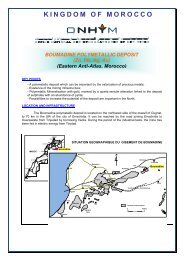LE GÏTE POLYMETALLIQUE A OR D'AZOUGAR N'TILILI
LE GÏTE POLYMETALLIQUE A OR D'AZOUGAR N'TILILI
LE GÏTE POLYMETALLIQUE A OR D'AZOUGAR N'TILILI
You also want an ePaper? Increase the reach of your titles
YUMPU automatically turns print PDFs into web optimized ePapers that Google loves.
KEY FEATURES<br />
KINGDOM OF M<strong>OR</strong>OCCO<br />
THE AZOUGAR N’TILILI GOLD AND POLYMETALLIC<br />
DEPOSIT (Au, Ag, Pb, Zn, Cu)<br />
(Anti-Atlas, Morocco)<br />
- Polymetallic mineralization with gold, related to quartz structures, hosted in Cambrian microconglomerate,<br />
sandstone, and carbonate formations.<br />
- The structures are in the form of a dense bundle of sub-parallel quartz veins.<br />
- The first 70 m of the formation slope can be mined from a hillside.<br />
- Free gold in quartz and in sulphides.<br />
- Possibility of the discovery of new structures towards the north.<br />
LOCATION AND INFRASTRUCTURE<br />
The polymetallic deposit of Azougar n’Tilili is located at the southwestern edge of the Bas Draa inlier, at the<br />
extreme southwest of the Anti Atlas. It is in the Tan Tan administrative province. The sector is covered by<br />
research permits N°1638018 to 1638022; 1638068; 1638075 and 1638090 (topographic sheet: Hassi Arsane at<br />
1/100 000 scale). It accessible by the road connecting Tan Tan to Lamsaide, heading southeast up to kilometer<br />
marker 22, then along a track 35 km towards the east.<br />
AD DAKHLA<br />
RABAT<br />
CASABLANCA<br />
Espagne<br />
TANGER<br />
FES<br />
MAROC AGADIR<br />
MARRAKECH<br />
OUARZAZATE<br />
TAZENAKHT<br />
LAGWIRA<br />
EL AYOUN<br />
Tafrent<br />
TAN TAN<br />
AZOUGAR N’TILILI<br />
OUJDA<br />
FIGUIG
REGIONAL GEOLOGY<br />
The Bas Draa inlier is formed in its central part by mica schists in the Lower Proterozoic, of slightly metamorphic<br />
grade and crossed by granitic bodies. The NE part comprises volcanic and volcano-clastic formations of Upper<br />
Proterozoic age. The SW part of the inlier is formed by volcanoclastic facies, also of Upper Proterozoic age.<br />
Infracambrian rocks consist mainly of sandstone and carbonate formations that surround the inlier.<br />
LOCAL GEOLOGY<br />
The gold bearing veins of Azougar n’Tilili are hosted principally by sandstones, microconglomerates, and<br />
carbonate formations, probably of Infracambrian to lower Cambrian age. They trend EW. Gold occurs in a set of<br />
quartz structures in a NE to NNE direction of variable extension and thickness, from 60 to 250 m long and 0.2 to 3<br />
m thick. The facies hosting these structures dip 50° to 70° to the south. Structurally, the sector is affected by<br />
schistosity S1 120° parallel to S0 and which is underlined in the pelitic bands by spotty mineralization. In thin<br />
sections the minerals are seen as green biotites, usually transformed into chlorites. The schistosity S2 is directed<br />
60° to 65° and is well expressed in the facies with medium and fine granularity. Brittle tectonics are demonstrated<br />
by quartz veins mainly oriented NNE, and showing maximum opening in the hard facies. These quartz veins<br />
exhibit both dextral and sinestral movements.<br />
EXPL<strong>OR</strong>ATION W<strong>OR</strong>K AND RESULTS<br />
In the Azougar n’Tilili sector, surface sampling shows four structures (AZ1, AZ3, AZ4 and AZ6) with the most<br />
interesting results. The AZ1 structure shows yields of 7 g/t Au, 2.42% Zn and 5.5% Pb over an extension of 250 m<br />
and 1.4 m of average thickness.
AZ1<br />
28<br />
27<br />
26<br />
-<br />
-<br />
AZS24<br />
DRILLHO<strong>LE</strong>S<br />
8-9<br />
16<br />
1-2<br />
-<br />
-<br />
6 -<br />
7<br />
8-9<br />
4 - -<br />
3 - AZS4 7<br />
4-6 -<br />
2 -<br />
AZ1-1 -<br />
10 -<br />
11-12<br />
-<br />
-<br />
-<br />
- AZS1<br />
13-14<br />
15<br />
5<br />
AZ3<br />
AZS5<br />
AZS3<br />
AZS2<br />
AZS17<br />
AZS23<br />
AZS18<br />
Légende Legend :<br />
Alternance Sandstones, des siltstones grès, siltites and pelites et pélites<br />
Grès Fine fins sandstones et pélitesand<br />
pelites<br />
Grès Fine rougeâtres sandstones, à siltstones niveaux fins and de pelites siltites et pélites<br />
microconglomérat<br />
microconglomerates<br />
Grès Sandstones grossiers and à microconglomérats<br />
microconglomerates<br />
Quartz veins<br />
Bas Draa inlier<br />
Geological BOUTONNIERE map of AZ1 and DE AZ3 BAS structures DRAA<br />
Levé géologique des structures AZ1 et AZ3<br />
0 30 60 Meters<br />
ECH.N° P(m) Au g/t Ag g/t Cu(%) Pb(%) Zn(%)<br />
AZ1_1 0,5 7,1 151,5 0,39 14,76 7,8<br />
AZ1_2 1,2 4,1 4 0,01 0,02 0,02<br />
AZ1_4 1,2 0,05 0,3 0,02 0,07 0,2<br />
AZ1_5 0,8 0,1 0,3 0,002 0,01 0,4<br />
AZ1-6 0,4 12,7 6,3 0,2 7,2 12,1<br />
AZ1_7 0,9 28<br />
AZ1_8 0,9 3,6 129 0,2 19 0,7<br />
AZ1_9 0,6 0,7 18,4 0,03 2,4 0,7<br />
AZ1_10 0,7 25,3 106,3 1,5 16,2 0,6<br />
AZ1_11 0,6 10,8 43,6 0,09 11,7 0,3<br />
AZ1_12 0,4 6,9 52,4 0,08 4,6 3,7<br />
AZ1_13 0,9 5,3 10,5 0,1 2,9 6,4<br />
AZ1_14 1,2 6,3 28,7 0,09 0,6 0,4<br />
AZ1_15 0,6 15,6 28 0,09 0,6 0,4<br />
AZ1_16 0,7 15,6 168,4 1,8 16,4 13,9<br />
AZ1_26 0,4 1,3 27,6 0,05 1,5 0,15<br />
AZ1_27 0,4 1,14 2,1 0,03 0,14 0,12<br />
AZ1_28 0,5 2,15 0,5 0,02 0,06 0,07<br />
ECH.N°P(m) Au g/t Ag g/t Cu(%) Pb(%) Zn(%)<br />
AZ3_1 0,4 0,03 0,3 0,03 0,3<br />
AZ3_2 0,4 1,3 34,4 0,04 2,4 0,7<br />
AZ3_3 0,4 40,6 69,7 0,03 3 0,03<br />
AZ3_4 0,4 24,2 0,3 0,01 0,01<br />
AZ3_5 1 3,3 170,4 0,3 13,6 15,6<br />
AZ3_6 0,8 12 14,8 0,02 1,35 1,65<br />
AZ3_7 0,7 0,3 203 0,44 23 12<br />
AZ3_8 0,8 0,06 0,3 0,18 0,27<br />
AZ3_9 0,4 0,08 3,8 0,36 0,38<br />
In the Ain Karma sector, the structures<br />
AK1 and AK4 have extensions of 400 m<br />
and 800 m and assays generally range<br />
from 0.1 to 6.2 g/t Au with exceptional<br />
yields of 67.5 and 147 g/t Au. Samples<br />
taken on structure AK4 over a 300 m extent<br />
have assays from 4.7 to 56 g/t Au,<br />
especially in the western vein wall, with<br />
thickness varying from 0.3 to 1.2 m.<br />
Following the encouraging results from surface sampling, a core drilling campaign totaling 2,731.75 m was<br />
carried out and made it possible to recognize structures at depths from 25 to 170 m. The average yield for each<br />
structure is as follows: AZ1: 8.1 g/t Au; 6.13% Zn; 6.62% Pb, and 63 g/t Ag with an average thickness of 1.24 m;<br />
AZ3: 6.68 g/t Au; 3.26 % Zn; 3.11% Pb, and 40 g/t Ag with an average thickness of 0.8 m; AZ4: 4.3g/t Au; 6.45%<br />
Zn; 3.9% Pb, and 22 g/t Ag; and AZ6: 2.55 g/t Au; 4.83% Zn; 4.3% Pb, and 25 g/t Ag with 1.85 m average<br />
thickness.<br />
Mineralization mainly consists of gold, silver, and sulphides of lead, zinc, and copper. Silver is closely related to<br />
lead. Zinc is also presented in oxidized form. Under the microscope, the paragenesis is diversified; it is in general
made up by native gold, pyrite, chalcopyrite, digenite, covellite, malachite, galena, sphalerite, hematite, and<br />
goethite. The texture of these minerals is disseminated and fissured. Native gold is often in a free state in the<br />
quartzose gangue and/or associated iron oxides in the form of grains scattered in the matrix or as agglomerates.<br />
It can be also in the form of inclusions associated with graphite. In certain sections gold is in inclusions in galena<br />
and sphalerite. The latter is often associated with chalcopyrite. The sphalerite fills sometimes the interstitial part of<br />
the facies by surrounding its contours.<br />
The resources estimation is made according two alternatives:<br />
- The first alternative (V1) where the mineralization is quartz veining.<br />
- The second alternative (V2) where the mineralization is ranked by the Zn content, which in general<br />
relates to the quartz structure and its immediate strata.<br />
The resources estimated for the first V1 alternative with a cut of grade of 0.4 g/t Au are:<br />
- Indicated resources: 328,700 T at 5.8 g/t Au; 5.4% Pb; 5.6% Zn, and 45.3 g/t Ag; average thickness is 1.4 m.<br />
- Inferred resources: 123,800 T at 5.5 g/t Au; 5.4% Pb; 5.7% Zn, and 43.2 g/t Ag; the average thickness is 1.4 m.<br />
The resources estimated for the second alternative V2 with a cut off grade of 0.6% zinc are:<br />
- Indicated resources: 825,500T at 3.6% Zn; 2.4 g/t Au; 2.2% Pb, and 19 g/t Ag; the average thickness is 4 m.<br />
- Indicated resources: 280,100 T at 3.5% Zn; 2.3 g/t Au; 2.2% Pb, and 19 g/t Ag; the average thickness is 4.3 m.<br />
FURTHER POTENTIAL<br />
The structures being explored appear to have significant vertical extensions. There is the potential of discovering<br />
other similar structures as the horizon hosting them surrounds the inlier. This deposit also suggests potential for<br />
prospecting for polymetallic mineralization in the Cambrian and Infracambrian formations of the Anti Atlas
For further information, please contact:<br />
Mrs Amina BENKHADRA<br />
General Director<br />
5, Avenue Moulay Hassan- BP 99 - Rabat, Morocco<br />
Tel. : + 212 37 23 98 98 – Fax : + 212 37 70 94 11<br />
E-mail : benkhadra@onhym.com<br />
Site web: www.onhym.com


